Case Study Scenario of Asim - Critical Social Work
VerifiedAdded on 2021/06/18
|9
|2536
|85
AI Summary
Contribute Materials
Your contribution can guide someone’s learning journey. Share your
documents today.
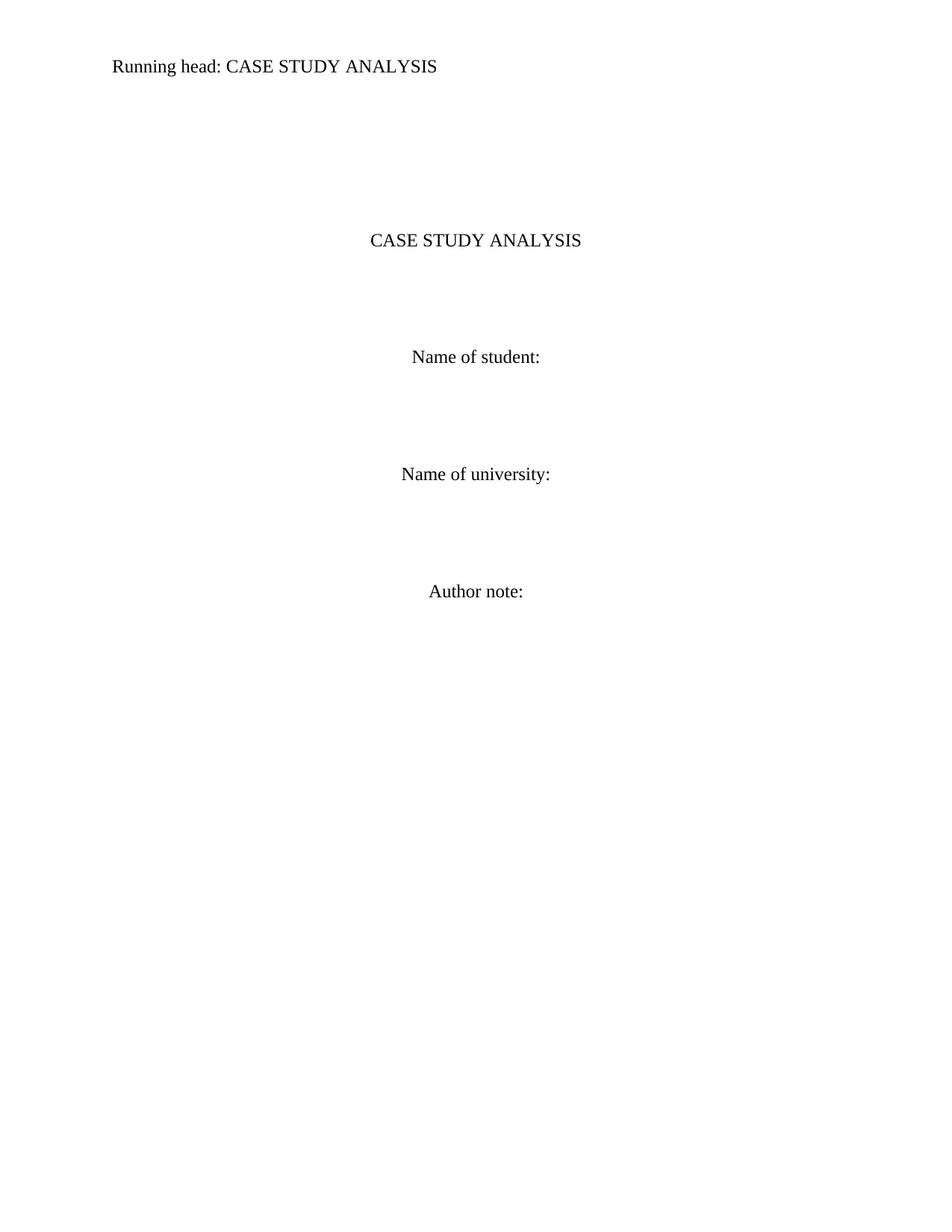
Running head: CASE STUDY ANALYSIS
CASE STUDY ANALYSIS
Name of student:
Name of university:
Author note:
CASE STUDY ANALYSIS
Name of student:
Name of university:
Author note:
Secure Best Marks with AI Grader
Need help grading? Try our AI Grader for instant feedback on your assignments.
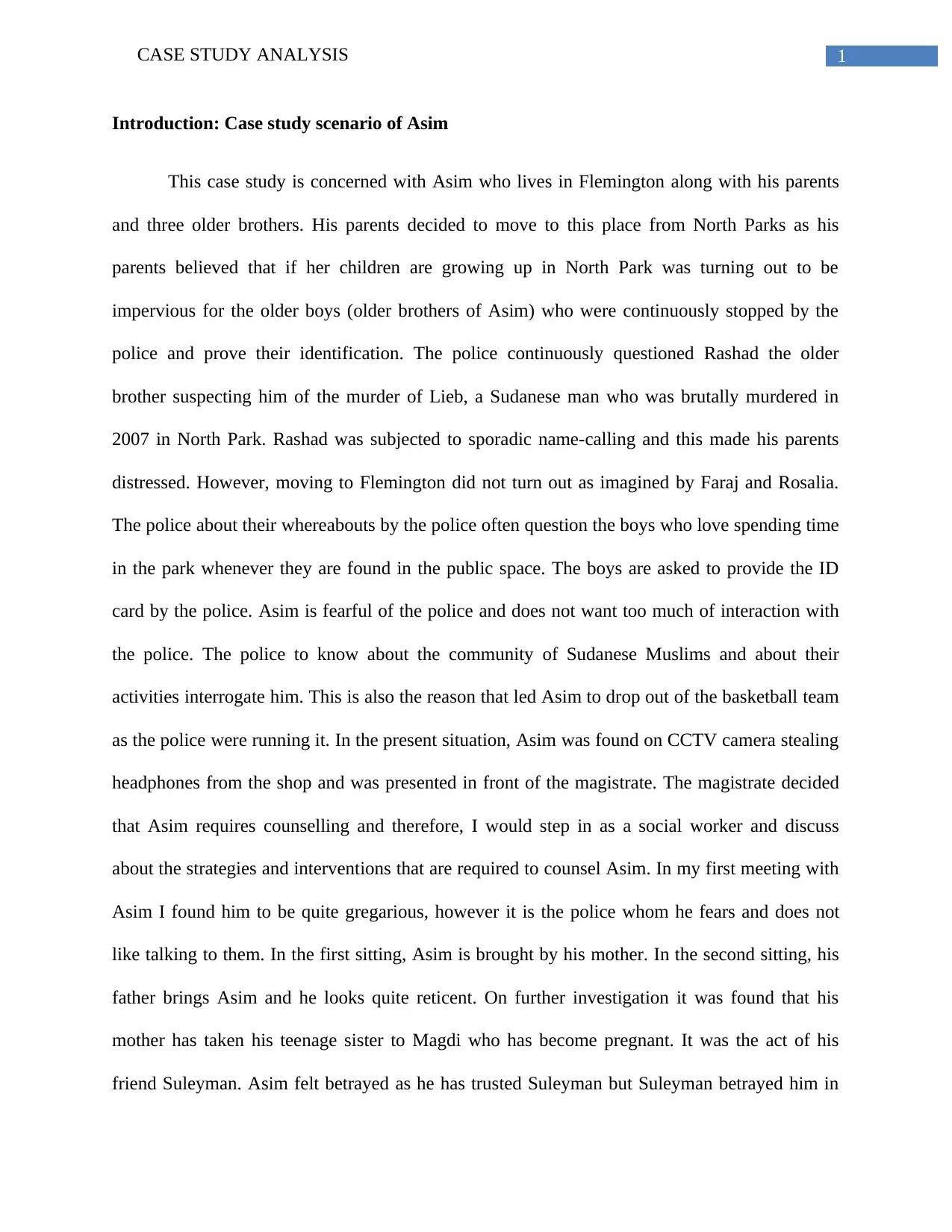
1CASE STUDY ANALYSIS
Introduction: Case study scenario of Asim
This case study is concerned with Asim who lives in Flemington along with his parents
and three older brothers. His parents decided to move to this place from North Parks as his
parents believed that if her children are growing up in North Park was turning out to be
impervious for the older boys (older brothers of Asim) who were continuously stopped by the
police and prove their identification. The police continuously questioned Rashad the older
brother suspecting him of the murder of Lieb, a Sudanese man who was brutally murdered in
2007 in North Park. Rashad was subjected to sporadic name-calling and this made his parents
distressed. However, moving to Flemington did not turn out as imagined by Faraj and Rosalia.
The police about their whereabouts by the police often question the boys who love spending time
in the park whenever they are found in the public space. The boys are asked to provide the ID
card by the police. Asim is fearful of the police and does not want too much of interaction with
the police. The police to know about the community of Sudanese Muslims and about their
activities interrogate him. This is also the reason that led Asim to drop out of the basketball team
as the police were running it. In the present situation, Asim was found on CCTV camera stealing
headphones from the shop and was presented in front of the magistrate. The magistrate decided
that Asim requires counselling and therefore, I would step in as a social worker and discuss
about the strategies and interventions that are required to counsel Asim. In my first meeting with
Asim I found him to be quite gregarious, however it is the police whom he fears and does not
like talking to them. In the first sitting, Asim is brought by his mother. In the second sitting, his
father brings Asim and he looks quite reticent. On further investigation it was found that his
mother has taken his teenage sister to Magdi who has become pregnant. It was the act of his
friend Suleyman. Asim felt betrayed as he has trusted Suleyman but Suleyman betrayed him in
Introduction: Case study scenario of Asim
This case study is concerned with Asim who lives in Flemington along with his parents
and three older brothers. His parents decided to move to this place from North Parks as his
parents believed that if her children are growing up in North Park was turning out to be
impervious for the older boys (older brothers of Asim) who were continuously stopped by the
police and prove their identification. The police continuously questioned Rashad the older
brother suspecting him of the murder of Lieb, a Sudanese man who was brutally murdered in
2007 in North Park. Rashad was subjected to sporadic name-calling and this made his parents
distressed. However, moving to Flemington did not turn out as imagined by Faraj and Rosalia.
The police about their whereabouts by the police often question the boys who love spending time
in the park whenever they are found in the public space. The boys are asked to provide the ID
card by the police. Asim is fearful of the police and does not want too much of interaction with
the police. The police to know about the community of Sudanese Muslims and about their
activities interrogate him. This is also the reason that led Asim to drop out of the basketball team
as the police were running it. In the present situation, Asim was found on CCTV camera stealing
headphones from the shop and was presented in front of the magistrate. The magistrate decided
that Asim requires counselling and therefore, I would step in as a social worker and discuss
about the strategies and interventions that are required to counsel Asim. In my first meeting with
Asim I found him to be quite gregarious, however it is the police whom he fears and does not
like talking to them. In the first sitting, Asim is brought by his mother. In the second sitting, his
father brings Asim and he looks quite reticent. On further investigation it was found that his
mother has taken his teenage sister to Magdi who has become pregnant. It was the act of his
friend Suleyman. Asim felt betrayed as he has trusted Suleyman but Suleyman betrayed him in
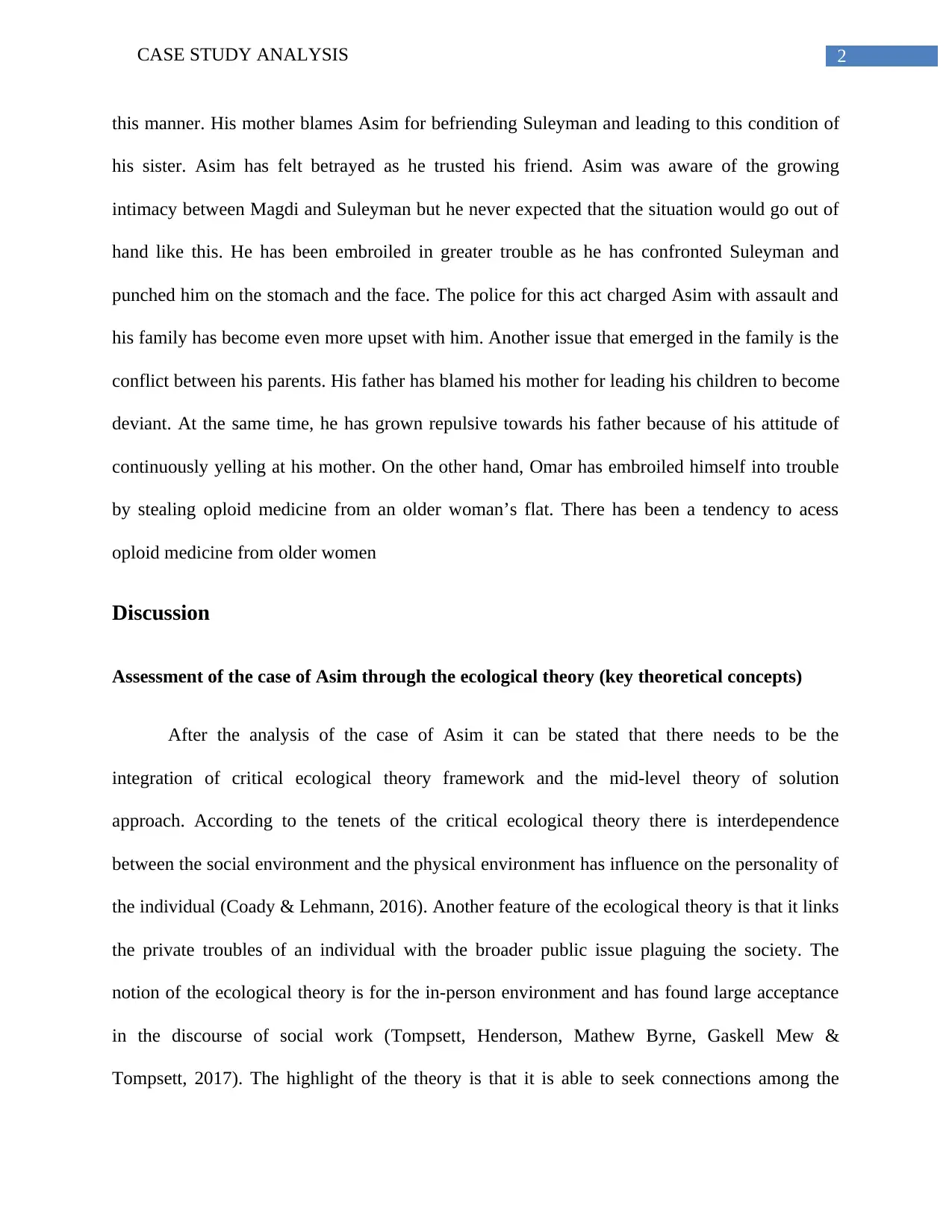
2CASE STUDY ANALYSIS
this manner. His mother blames Asim for befriending Suleyman and leading to this condition of
his sister. Asim has felt betrayed as he trusted his friend. Asim was aware of the growing
intimacy between Magdi and Suleyman but he never expected that the situation would go out of
hand like this. He has been embroiled in greater trouble as he has confronted Suleyman and
punched him on the stomach and the face. The police for this act charged Asim with assault and
his family has become even more upset with him. Another issue that emerged in the family is the
conflict between his parents. His father has blamed his mother for leading his children to become
deviant. At the same time, he has grown repulsive towards his father because of his attitude of
continuously yelling at his mother. On the other hand, Omar has embroiled himself into trouble
by stealing oploid medicine from an older woman’s flat. There has been a tendency to acess
oploid medicine from older women
Discussion
Assessment of the case of Asim through the ecological theory (key theoretical concepts)
After the analysis of the case of Asim it can be stated that there needs to be the
integration of critical ecological theory framework and the mid-level theory of solution
approach. According to the tenets of the critical ecological theory there is interdependence
between the social environment and the physical environment has influence on the personality of
the individual (Coady & Lehmann, 2016). Another feature of the ecological theory is that it links
the private troubles of an individual with the broader public issue plaguing the society. The
notion of the ecological theory is for the in-person environment and has found large acceptance
in the discourse of social work (Tompsett, Henderson, Mathew Byrne, Gaskell Mew &
Tompsett, 2017). The highlight of the theory is that it is able to seek connections among the
this manner. His mother blames Asim for befriending Suleyman and leading to this condition of
his sister. Asim has felt betrayed as he trusted his friend. Asim was aware of the growing
intimacy between Magdi and Suleyman but he never expected that the situation would go out of
hand like this. He has been embroiled in greater trouble as he has confronted Suleyman and
punched him on the stomach and the face. The police for this act charged Asim with assault and
his family has become even more upset with him. Another issue that emerged in the family is the
conflict between his parents. His father has blamed his mother for leading his children to become
deviant. At the same time, he has grown repulsive towards his father because of his attitude of
continuously yelling at his mother. On the other hand, Omar has embroiled himself into trouble
by stealing oploid medicine from an older woman’s flat. There has been a tendency to acess
oploid medicine from older women
Discussion
Assessment of the case of Asim through the ecological theory (key theoretical concepts)
After the analysis of the case of Asim it can be stated that there needs to be the
integration of critical ecological theory framework and the mid-level theory of solution
approach. According to the tenets of the critical ecological theory there is interdependence
between the social environment and the physical environment has influence on the personality of
the individual (Coady & Lehmann, 2016). Another feature of the ecological theory is that it links
the private troubles of an individual with the broader public issue plaguing the society. The
notion of the ecological theory is for the in-person environment and has found large acceptance
in the discourse of social work (Tompsett, Henderson, Mathew Byrne, Gaskell Mew &
Tompsett, 2017). The highlight of the theory is that it is able to seek connections among the
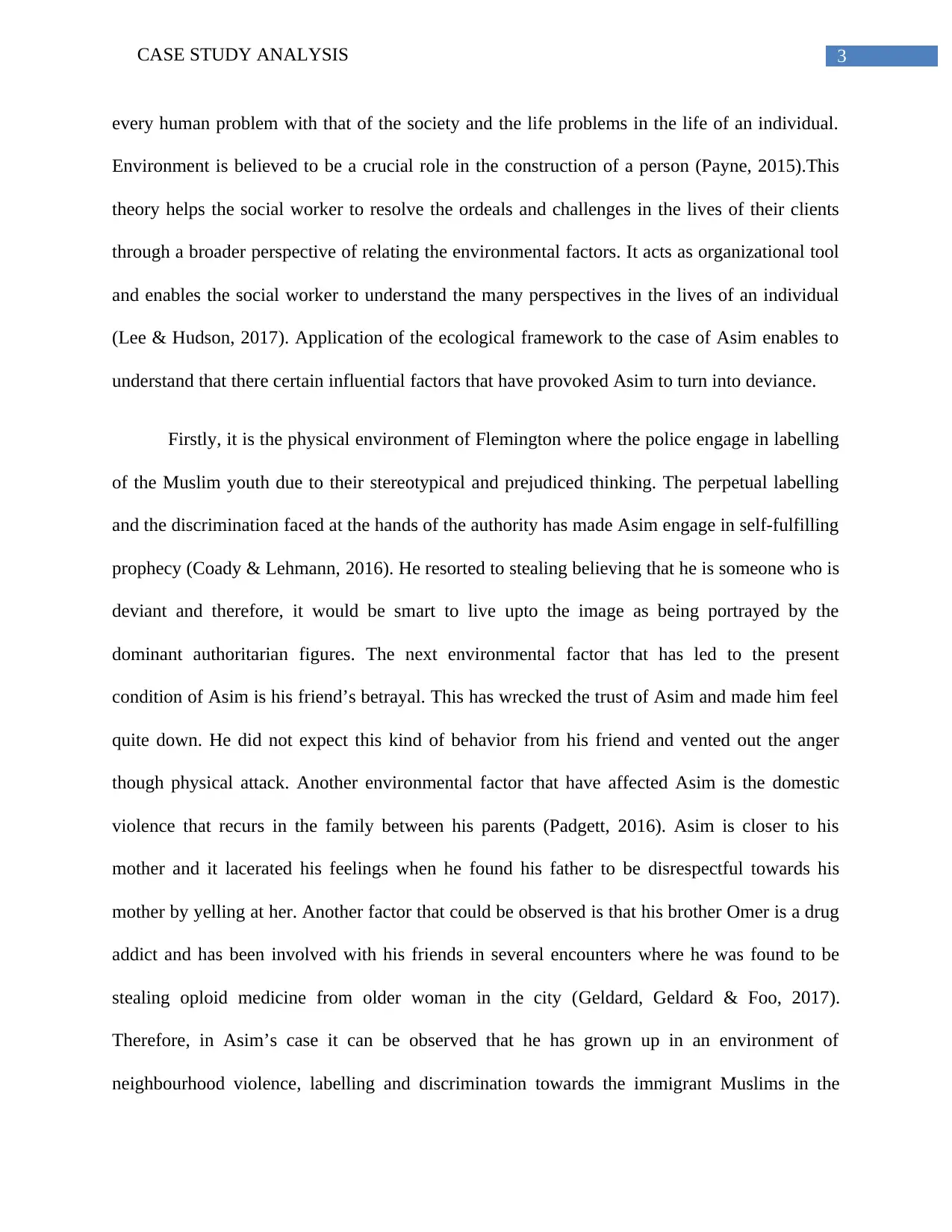
3CASE STUDY ANALYSIS
every human problem with that of the society and the life problems in the life of an individual.
Environment is believed to be a crucial role in the construction of a person (Payne, 2015).This
theory helps the social worker to resolve the ordeals and challenges in the lives of their clients
through a broader perspective of relating the environmental factors. It acts as organizational tool
and enables the social worker to understand the many perspectives in the lives of an individual
(Lee & Hudson, 2017). Application of the ecological framework to the case of Asim enables to
understand that there certain influential factors that have provoked Asim to turn into deviance.
Firstly, it is the physical environment of Flemington where the police engage in labelling
of the Muslim youth due to their stereotypical and prejudiced thinking. The perpetual labelling
and the discrimination faced at the hands of the authority has made Asim engage in self-fulfilling
prophecy (Coady & Lehmann, 2016). He resorted to stealing believing that he is someone who is
deviant and therefore, it would be smart to live upto the image as being portrayed by the
dominant authoritarian figures. The next environmental factor that has led to the present
condition of Asim is his friend’s betrayal. This has wrecked the trust of Asim and made him feel
quite down. He did not expect this kind of behavior from his friend and vented out the anger
though physical attack. Another environmental factor that have affected Asim is the domestic
violence that recurs in the family between his parents (Padgett, 2016). Asim is closer to his
mother and it lacerated his feelings when he found his father to be disrespectful towards his
mother by yelling at her. Another factor that could be observed is that his brother Omer is a drug
addict and has been involved with his friends in several encounters where he was found to be
stealing oploid medicine from older woman in the city (Geldard, Geldard & Foo, 2017).
Therefore, in Asim’s case it can be observed that he has grown up in an environment of
neighbourhood violence, labelling and discrimination towards the immigrant Muslims in the
every human problem with that of the society and the life problems in the life of an individual.
Environment is believed to be a crucial role in the construction of a person (Payne, 2015).This
theory helps the social worker to resolve the ordeals and challenges in the lives of their clients
through a broader perspective of relating the environmental factors. It acts as organizational tool
and enables the social worker to understand the many perspectives in the lives of an individual
(Lee & Hudson, 2017). Application of the ecological framework to the case of Asim enables to
understand that there certain influential factors that have provoked Asim to turn into deviance.
Firstly, it is the physical environment of Flemington where the police engage in labelling
of the Muslim youth due to their stereotypical and prejudiced thinking. The perpetual labelling
and the discrimination faced at the hands of the authority has made Asim engage in self-fulfilling
prophecy (Coady & Lehmann, 2016). He resorted to stealing believing that he is someone who is
deviant and therefore, it would be smart to live upto the image as being portrayed by the
dominant authoritarian figures. The next environmental factor that has led to the present
condition of Asim is his friend’s betrayal. This has wrecked the trust of Asim and made him feel
quite down. He did not expect this kind of behavior from his friend and vented out the anger
though physical attack. Another environmental factor that have affected Asim is the domestic
violence that recurs in the family between his parents (Padgett, 2016). Asim is closer to his
mother and it lacerated his feelings when he found his father to be disrespectful towards his
mother by yelling at her. Another factor that could be observed is that his brother Omer is a drug
addict and has been involved with his friends in several encounters where he was found to be
stealing oploid medicine from older woman in the city (Geldard, Geldard & Foo, 2017).
Therefore, in Asim’s case it can be observed that he has grown up in an environment of
neighbourhood violence, labelling and discrimination towards the immigrant Muslims in the
Secure Best Marks with AI Grader
Need help grading? Try our AI Grader for instant feedback on your assignments.
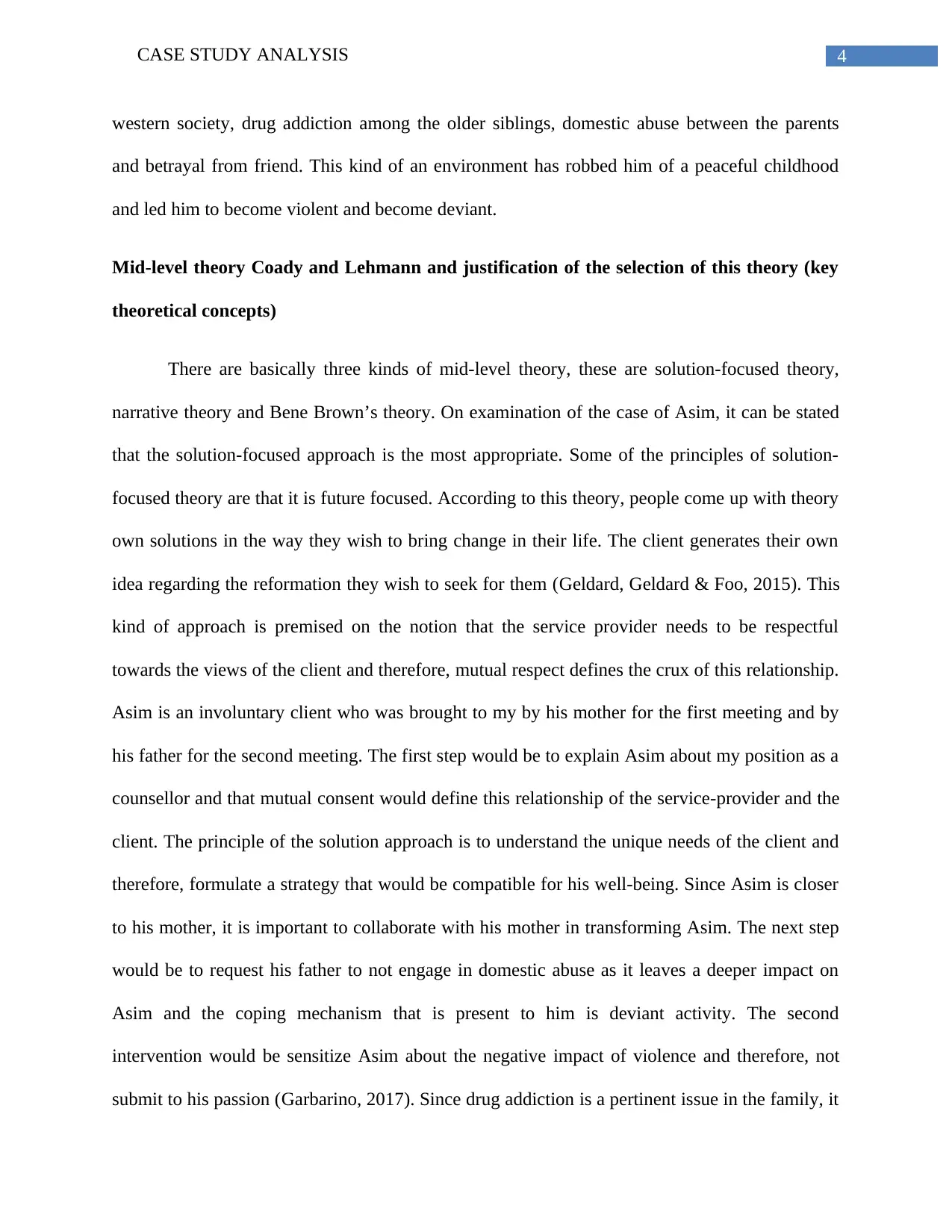
4CASE STUDY ANALYSIS
western society, drug addiction among the older siblings, domestic abuse between the parents
and betrayal from friend. This kind of an environment has robbed him of a peaceful childhood
and led him to become violent and become deviant.
Mid-level theory Coady and Lehmann and justification of the selection of this theory (key
theoretical concepts)
There are basically three kinds of mid-level theory, these are solution-focused theory,
narrative theory and Bene Brown’s theory. On examination of the case of Asim, it can be stated
that the solution-focused approach is the most appropriate. Some of the principles of solution-
focused theory are that it is future focused. According to this theory, people come up with theory
own solutions in the way they wish to bring change in their life. The client generates their own
idea regarding the reformation they wish to seek for them (Geldard, Geldard & Foo, 2015). This
kind of approach is premised on the notion that the service provider needs to be respectful
towards the views of the client and therefore, mutual respect defines the crux of this relationship.
Asim is an involuntary client who was brought to my by his mother for the first meeting and by
his father for the second meeting. The first step would be to explain Asim about my position as a
counsellor and that mutual consent would define this relationship of the service-provider and the
client. The principle of the solution approach is to understand the unique needs of the client and
therefore, formulate a strategy that would be compatible for his well-being. Since Asim is closer
to his mother, it is important to collaborate with his mother in transforming Asim. The next step
would be to request his father to not engage in domestic abuse as it leaves a deeper impact on
Asim and the coping mechanism that is present to him is deviant activity. The second
intervention would be sensitize Asim about the negative impact of violence and therefore, not
submit to his passion (Garbarino, 2017). Since drug addiction is a pertinent issue in the family, it
western society, drug addiction among the older siblings, domestic abuse between the parents
and betrayal from friend. This kind of an environment has robbed him of a peaceful childhood
and led him to become violent and become deviant.
Mid-level theory Coady and Lehmann and justification of the selection of this theory (key
theoretical concepts)
There are basically three kinds of mid-level theory, these are solution-focused theory,
narrative theory and Bene Brown’s theory. On examination of the case of Asim, it can be stated
that the solution-focused approach is the most appropriate. Some of the principles of solution-
focused theory are that it is future focused. According to this theory, people come up with theory
own solutions in the way they wish to bring change in their life. The client generates their own
idea regarding the reformation they wish to seek for them (Geldard, Geldard & Foo, 2015). This
kind of approach is premised on the notion that the service provider needs to be respectful
towards the views of the client and therefore, mutual respect defines the crux of this relationship.
Asim is an involuntary client who was brought to my by his mother for the first meeting and by
his father for the second meeting. The first step would be to explain Asim about my position as a
counsellor and that mutual consent would define this relationship of the service-provider and the
client. The principle of the solution approach is to understand the unique needs of the client and
therefore, formulate a strategy that would be compatible for his well-being. Since Asim is closer
to his mother, it is important to collaborate with his mother in transforming Asim. The next step
would be to request his father to not engage in domestic abuse as it leaves a deeper impact on
Asim and the coping mechanism that is present to him is deviant activity. The second
intervention would be sensitize Asim about the negative impact of violence and therefore, not
submit to his passion (Garbarino, 2017). Since drug addiction is a pertinent issue in the family, it
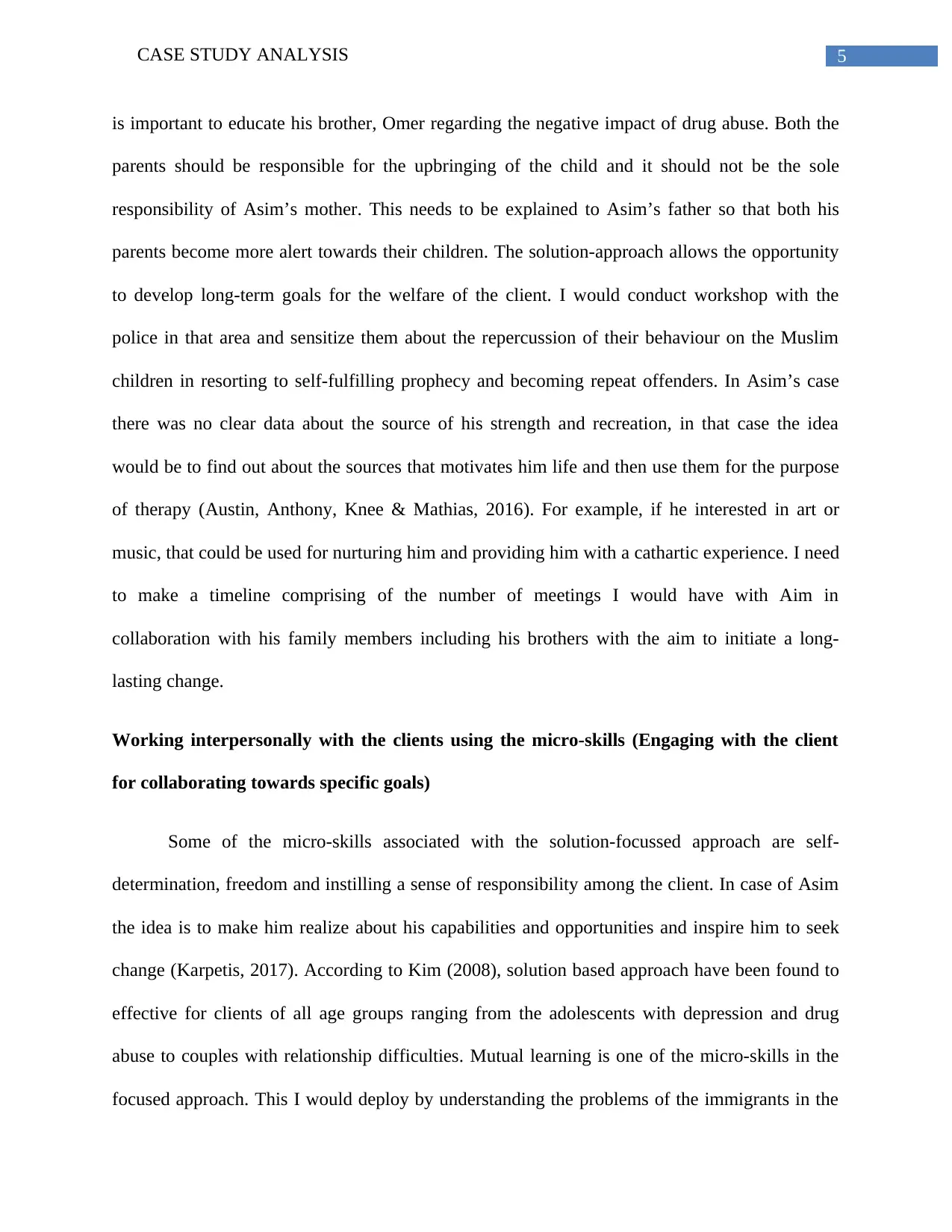
5CASE STUDY ANALYSIS
is important to educate his brother, Omer regarding the negative impact of drug abuse. Both the
parents should be responsible for the upbringing of the child and it should not be the sole
responsibility of Asim’s mother. This needs to be explained to Asim’s father so that both his
parents become more alert towards their children. The solution-approach allows the opportunity
to develop long-term goals for the welfare of the client. I would conduct workshop with the
police in that area and sensitize them about the repercussion of their behaviour on the Muslim
children in resorting to self-fulfilling prophecy and becoming repeat offenders. In Asim’s case
there was no clear data about the source of his strength and recreation, in that case the idea
would be to find out about the sources that motivates him life and then use them for the purpose
of therapy (Austin, Anthony, Knee & Mathias, 2016). For example, if he interested in art or
music, that could be used for nurturing him and providing him with a cathartic experience. I need
to make a timeline comprising of the number of meetings I would have with Aim in
collaboration with his family members including his brothers with the aim to initiate a long-
lasting change.
Working interpersonally with the clients using the micro-skills (Engaging with the client
for collaborating towards specific goals)
Some of the micro-skills associated with the solution-focussed approach are self-
determination, freedom and instilling a sense of responsibility among the client. In case of Asim
the idea is to make him realize about his capabilities and opportunities and inspire him to seek
change (Karpetis, 2017). According to Kim (2008), solution based approach have been found to
effective for clients of all age groups ranging from the adolescents with depression and drug
abuse to couples with relationship difficulties. Mutual learning is one of the micro-skills in the
focused approach. This I would deploy by understanding the problems of the immigrants in the
is important to educate his brother, Omer regarding the negative impact of drug abuse. Both the
parents should be responsible for the upbringing of the child and it should not be the sole
responsibility of Asim’s mother. This needs to be explained to Asim’s father so that both his
parents become more alert towards their children. The solution-approach allows the opportunity
to develop long-term goals for the welfare of the client. I would conduct workshop with the
police in that area and sensitize them about the repercussion of their behaviour on the Muslim
children in resorting to self-fulfilling prophecy and becoming repeat offenders. In Asim’s case
there was no clear data about the source of his strength and recreation, in that case the idea
would be to find out about the sources that motivates him life and then use them for the purpose
of therapy (Austin, Anthony, Knee & Mathias, 2016). For example, if he interested in art or
music, that could be used for nurturing him and providing him with a cathartic experience. I need
to make a timeline comprising of the number of meetings I would have with Aim in
collaboration with his family members including his brothers with the aim to initiate a long-
lasting change.
Working interpersonally with the clients using the micro-skills (Engaging with the client
for collaborating towards specific goals)
Some of the micro-skills associated with the solution-focussed approach are self-
determination, freedom and instilling a sense of responsibility among the client. In case of Asim
the idea is to make him realize about his capabilities and opportunities and inspire him to seek
change (Karpetis, 2017). According to Kim (2008), solution based approach have been found to
effective for clients of all age groups ranging from the adolescents with depression and drug
abuse to couples with relationship difficulties. Mutual learning is one of the micro-skills in the
focused approach. This I would deploy by understanding the problems of the immigrants in the
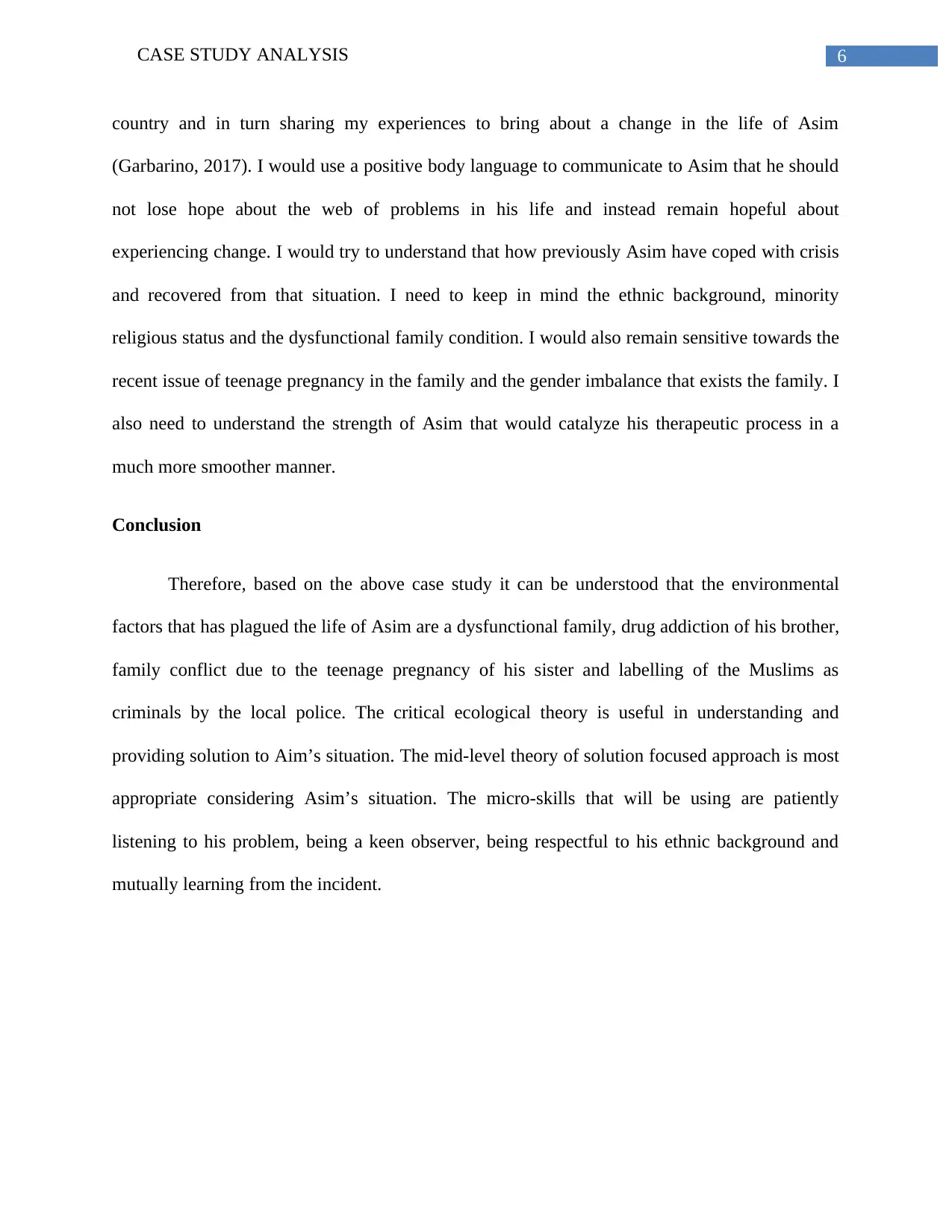
6CASE STUDY ANALYSIS
country and in turn sharing my experiences to bring about a change in the life of Asim
(Garbarino, 2017). I would use a positive body language to communicate to Asim that he should
not lose hope about the web of problems in his life and instead remain hopeful about
experiencing change. I would try to understand that how previously Asim have coped with crisis
and recovered from that situation. I need to keep in mind the ethnic background, minority
religious status and the dysfunctional family condition. I would also remain sensitive towards the
recent issue of teenage pregnancy in the family and the gender imbalance that exists the family. I
also need to understand the strength of Asim that would catalyze his therapeutic process in a
much more smoother manner.
Conclusion
Therefore, based on the above case study it can be understood that the environmental
factors that has plagued the life of Asim are a dysfunctional family, drug addiction of his brother,
family conflict due to the teenage pregnancy of his sister and labelling of the Muslims as
criminals by the local police. The critical ecological theory is useful in understanding and
providing solution to Aim’s situation. The mid-level theory of solution focused approach is most
appropriate considering Asim’s situation. The micro-skills that will be using are patiently
listening to his problem, being a keen observer, being respectful to his ethnic background and
mutually learning from the incident.
country and in turn sharing my experiences to bring about a change in the life of Asim
(Garbarino, 2017). I would use a positive body language to communicate to Asim that he should
not lose hope about the web of problems in his life and instead remain hopeful about
experiencing change. I would try to understand that how previously Asim have coped with crisis
and recovered from that situation. I need to keep in mind the ethnic background, minority
religious status and the dysfunctional family condition. I would also remain sensitive towards the
recent issue of teenage pregnancy in the family and the gender imbalance that exists the family. I
also need to understand the strength of Asim that would catalyze his therapeutic process in a
much more smoother manner.
Conclusion
Therefore, based on the above case study it can be understood that the environmental
factors that has plagued the life of Asim are a dysfunctional family, drug addiction of his brother,
family conflict due to the teenage pregnancy of his sister and labelling of the Muslims as
criminals by the local police. The critical ecological theory is useful in understanding and
providing solution to Aim’s situation. The mid-level theory of solution focused approach is most
appropriate considering Asim’s situation. The micro-skills that will be using are patiently
listening to his problem, being a keen observer, being respectful to his ethnic background and
mutually learning from the incident.
Paraphrase This Document
Need a fresh take? Get an instant paraphrase of this document with our AI Paraphraser
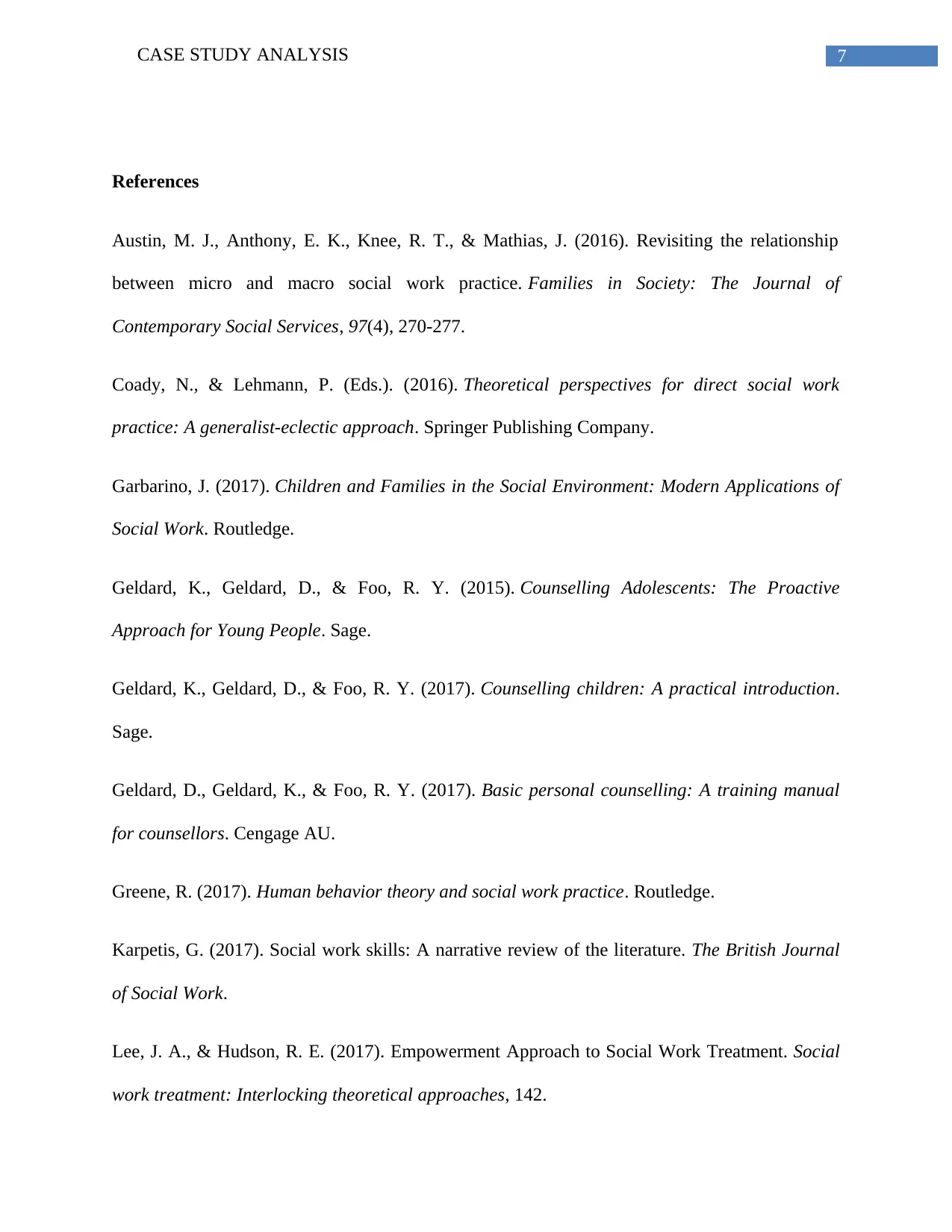
7CASE STUDY ANALYSIS
References
Austin, M. J., Anthony, E. K., Knee, R. T., & Mathias, J. (2016). Revisiting the relationship
between micro and macro social work practice. Families in Society: The Journal of
Contemporary Social Services, 97(4), 270-277.
Coady, N., & Lehmann, P. (Eds.). (2016). Theoretical perspectives for direct social work
practice: A generalist-eclectic approach. Springer Publishing Company.
Garbarino, J. (2017). Children and Families in the Social Environment: Modern Applications of
Social Work. Routledge.
Geldard, K., Geldard, D., & Foo, R. Y. (2015). Counselling Adolescents: The Proactive
Approach for Young People. Sage.
Geldard, K., Geldard, D., & Foo, R. Y. (2017). Counselling children: A practical introduction.
Sage.
Geldard, D., Geldard, K., & Foo, R. Y. (2017). Basic personal counselling: A training manual
for counsellors. Cengage AU.
Greene, R. (2017). Human behavior theory and social work practice. Routledge.
Karpetis, G. (2017). Social work skills: A narrative review of the literature. The British Journal
of Social Work.
Lee, J. A., & Hudson, R. E. (2017). Empowerment Approach to Social Work Treatment. Social
work treatment: Interlocking theoretical approaches, 142.
References
Austin, M. J., Anthony, E. K., Knee, R. T., & Mathias, J. (2016). Revisiting the relationship
between micro and macro social work practice. Families in Society: The Journal of
Contemporary Social Services, 97(4), 270-277.
Coady, N., & Lehmann, P. (Eds.). (2016). Theoretical perspectives for direct social work
practice: A generalist-eclectic approach. Springer Publishing Company.
Garbarino, J. (2017). Children and Families in the Social Environment: Modern Applications of
Social Work. Routledge.
Geldard, K., Geldard, D., & Foo, R. Y. (2015). Counselling Adolescents: The Proactive
Approach for Young People. Sage.
Geldard, K., Geldard, D., & Foo, R. Y. (2017). Counselling children: A practical introduction.
Sage.
Geldard, D., Geldard, K., & Foo, R. Y. (2017). Basic personal counselling: A training manual
for counsellors. Cengage AU.
Greene, R. (2017). Human behavior theory and social work practice. Routledge.
Karpetis, G. (2017). Social work skills: A narrative review of the literature. The British Journal
of Social Work.
Lee, J. A., & Hudson, R. E. (2017). Empowerment Approach to Social Work Treatment. Social
work treatment: Interlocking theoretical approaches, 142.
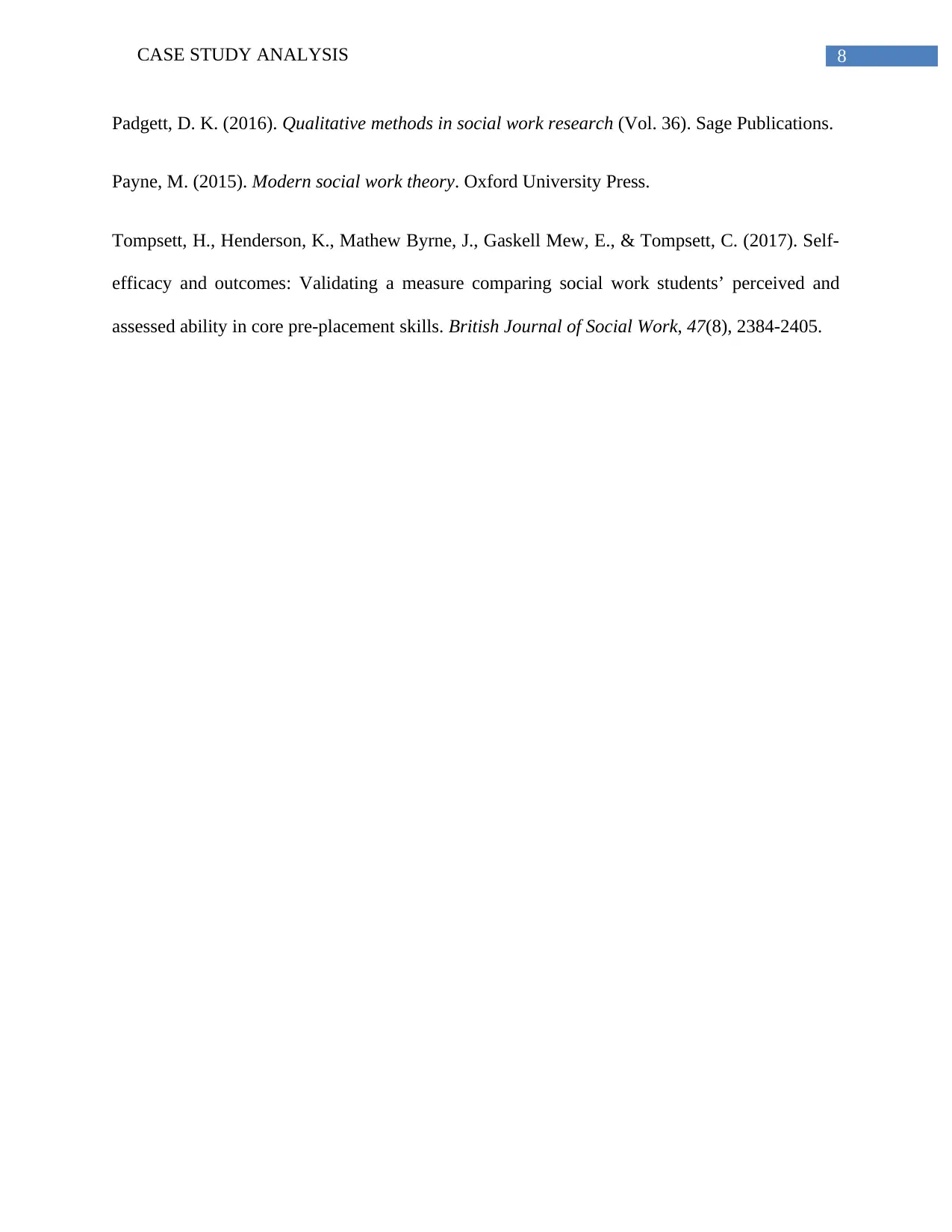
8CASE STUDY ANALYSIS
Padgett, D. K. (2016). Qualitative methods in social work research (Vol. 36). Sage Publications.
Payne, M. (2015). Modern social work theory. Oxford University Press.
Tompsett, H., Henderson, K., Mathew Byrne, J., Gaskell Mew, E., & Tompsett, C. (2017). Self-
efficacy and outcomes: Validating a measure comparing social work students’ perceived and
assessed ability in core pre-placement skills. British Journal of Social Work, 47(8), 2384-2405.
Padgett, D. K. (2016). Qualitative methods in social work research (Vol. 36). Sage Publications.
Payne, M. (2015). Modern social work theory. Oxford University Press.
Tompsett, H., Henderson, K., Mathew Byrne, J., Gaskell Mew, E., & Tompsett, C. (2017). Self-
efficacy and outcomes: Validating a measure comparing social work students’ perceived and
assessed ability in core pre-placement skills. British Journal of Social Work, 47(8), 2384-2405.
1 out of 9
Your All-in-One AI-Powered Toolkit for Academic Success.
+13062052269
info@desklib.com
Available 24*7 on WhatsApp / Email
![[object Object]](/_next/static/media/star-bottom.7253800d.svg)
Unlock your academic potential
© 2024 | Zucol Services PVT LTD | All rights reserved.